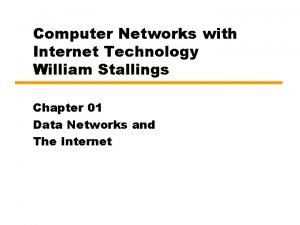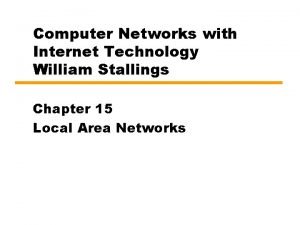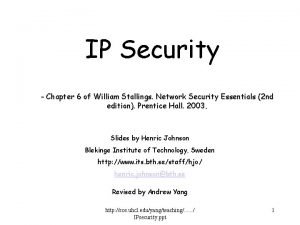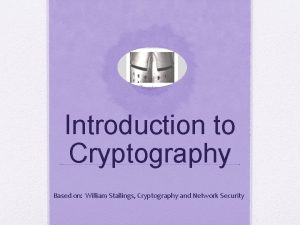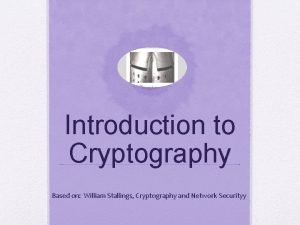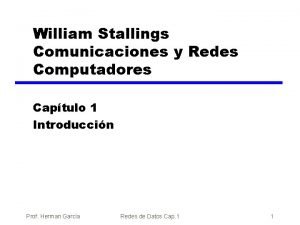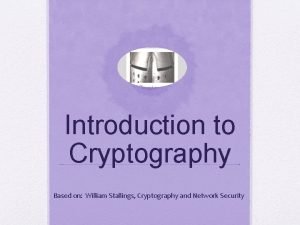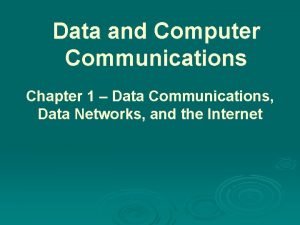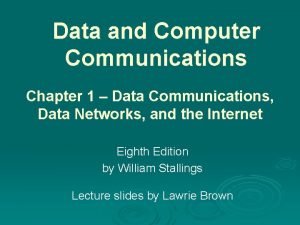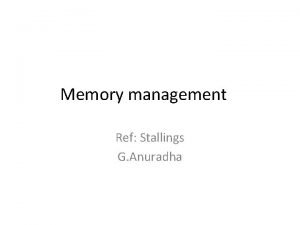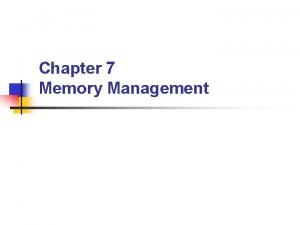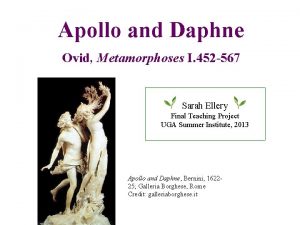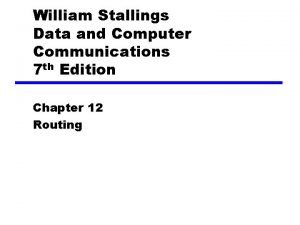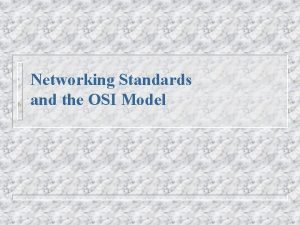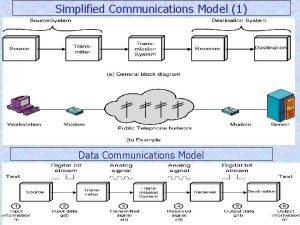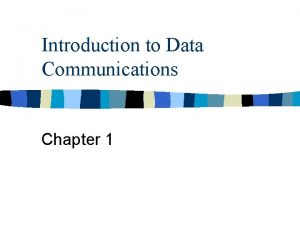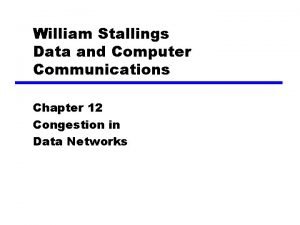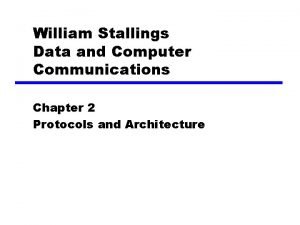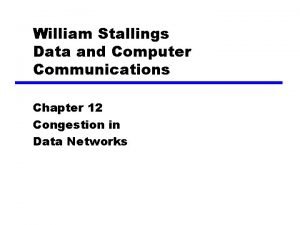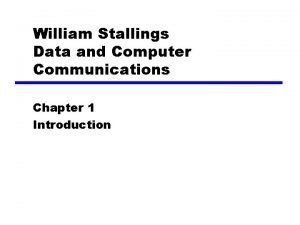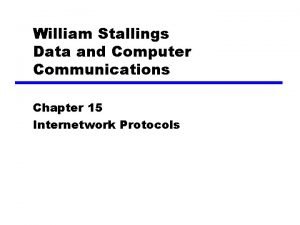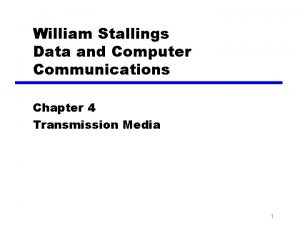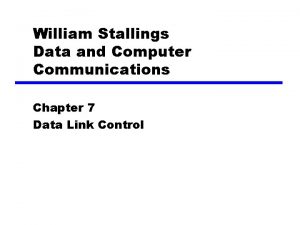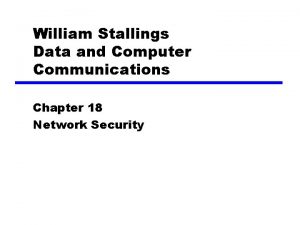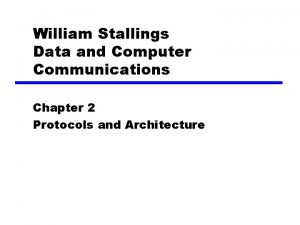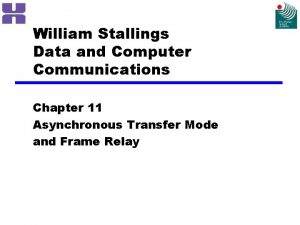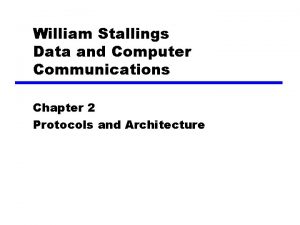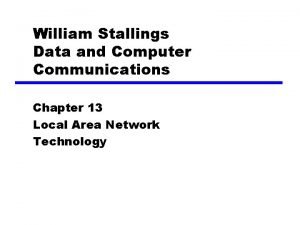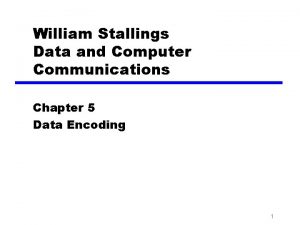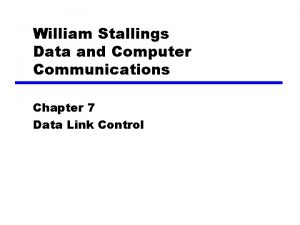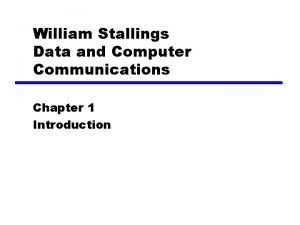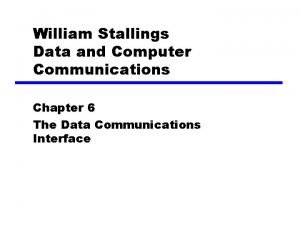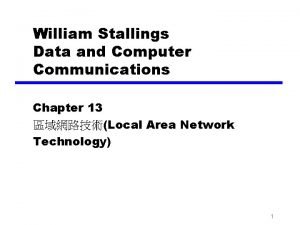William Stallings Data and Computer Communications Chapter 19




























- Slides: 28

William Stallings Data and Computer Communications Chapter 19 Distributed Applications (e-mail and www)

Electronic Mail z Most heavily used application on any network z Simple Mail Transfer Protocol (SMTP) y. Delivery of simple text messages z Multi-purpose Internet Mail Extension (MIME) y. Delivery of other types of data y. Voice, images, video clips

SMTP z RFC 821 z Not concerned with format of messages or data y. Covered in RFC 822 (see later) z SMTP uses info written on “envelope” y. Message header z Does not look at contents z Except: y. Standard character set: 7 bit ASCII y. Add log info to start of message x. Shows path taken

SMTP Mail Flow

Mail Message Contents z Each queued message has: y. Message text y. A list of mail destinations

SMTP Sender z Takes message from queue z Transmits to proper destination host y. Via SMTP transaction y. Over one or more TCP connections to port 25 z When delivery is completed, sender deletes destination from list for that message z When all destinations processed, message is deleted

Possible Errors z Host unreachable z Host out of operation z TCP connection fail during transfer z Sender can re-queue mail y. Give up after a period z Faulty destination address y. User error y. Target user changed address y. Redirect if possible y. Inform user if not

SMTP Protocol - Reliability z Used to transfer messages from sender to receiver over TCP connection z Attempts to provide reliable service z No guarantee to recover lost messages z No end to end acknowledgment to originator z Generally considered reliable

SMTP Receiver z Accepts arriving message z Places in user mailbox or copies to outgoing queue forwarding z Sender responsible for message until receiver confirm complete transfer y. Indicates mail has arrived at host, not user

Scope of SMTP z SMTP limited to conversation between sender and receiver z Main function is to transfer messages z Rest of mail handling beyond scope of SMTP y. May differ between systems

SMTP System Overview z Commands and responses between sender and receiver over a TCP connection y. Sender sends commands to receiver y. Each command generates exactly one reply z Basic SMTP operation y. Connection setup y. Mail transfer y. Connection termination

Connection Setup z Sender opens TCP connection with receiver z Once connected, receiver identifies itself y 220 <domain> service ready z Sender identifies itself y. HELO z Receiver accepts sender’s identification y 250 OK z If mail service not available, step 2 above becomes: y 421 service not available

Mail Transfer z Sender may send one or more messages to receiver z MAIL command identifies originator y. Receiver returns 250 OK or appropriate fail/error message z One or more RCPT commands identifies recipients for the message y. Separate reply for each recipient z DATA command transfers message text y. End of message indicated by line containing just period (. )

RFC 882 z Format for text messages z Message is sequence of lines of text y. Uses general memo framework y. Header usually keyword followed by colon followed by arguments z Example: Date: Tue, 16 Jan 1996 10: 37: 17 (EST) From: “William Stallings” <ws@host. com> Subject: The syntax of RFC 822 To: Smith@otherhost. com Cc: Jones@Yet-another_host. com This is the main text, delimited from the header by a blank line.

Multipurpose Internet Mail Extension (MIME) z Extension to RFC 822 z SMTP can not transmit executables or binary y Uuencode and other schemes are available z Can not transmit text including international characters (e. g. â, å, ä, è, é, ê, ë) y RFC 822 is 7 -bit ASCII, need 8 -bit ASCII z MIME y RFCs 2045, 2046, 2047, 2048 and 2049

Overview of MIME z Different applications can be bundled into a single message yaudio, video, text, image yapplications

MIME Transfer Encodings z Reliable delivery across wide largest range of environments z Content transfer encoding field y Six values y Three (7 bit, 8 bit, binary) no encoding done x. Provide info about nature of data z Quoted-printable y useful when data is largely printable ASCII characters y printable characters are not encoded y Non-printing characters represented by hex code z Base 64 y Maps arbitrary binary input onto printable output

Base 64 Encoding

Hypertext Transfer Protocol HTTP z Underlying protocol of the World Wide Web z Can transfer plain text, hypertext, audio, images, and Internet accessible information

HTTP Overview z Transaction oriented client/server protocol z Usually between Web browser (client) and Web server z Uses TCP connections z Stateless y. Each transaction treated independently y. New TCP connection for each transaction y. Terminate connection when transaction completes

Examples of HTTP Operation

HTTP Messages z Simple request/response mechanism z Requests y. Client to server z Responses y. Server to client

HTTP Message Structure

Request z Request-Line = Method <SP> Request_URL <SP> HTTP-Version <CRLF> z Several Methods - some examples y Get y Head y Delete y Put

Request Header Field z Additional parameters about requests - some examples y Accept charset y Accept language y If modified since y Referrer y User agent

Response Messages z Status line followed by one or more general, response and entity headers, followed by optional entity body z Status-Line = HTTP-Version <SP> Status-Code <SP> Reason-Phrase <CRLF> z Response Header Fields - an example y. Server (info about server software)

Entity Header z Optional information about the entity - some examples y. Content language y. Content length y. Content type y. Last modified

Entity Body z Actual Data z HTTP transfers any type of data including: ytext ybinary data yaudio yimages yvideo z Interpretation of data determined by header fields
 William stallings data and computer communications
William stallings data and computer communications Computer organization and architecture stallings
Computer organization and architecture stallings William stallings computer networks
William stallings computer networks William stallings computer networks
William stallings computer networks William stallings network security essentials 5th edition
William stallings network security essentials 5th edition Network security essentials william stallings ppt
Network security essentials william stallings ppt William stallings
William stallings Congruence relation
Congruence relation Stallings william comunicaciones y redes de computadores
Stallings william comunicaciones y redes de computadores Cryptography william stallings
Cryptography william stallings Data and computer communications 10th edition
Data and computer communications 10th edition Data & computer communications
Data & computer communications Data and computer communications
Data and computer communications Stallings garbage pickup
Stallings garbage pickup Garbage pickup stallings
Garbage pickup stallings Apolo y dafne metamorphoses i
Apolo y dafne metamorphoses i Metodo stallings
Metodo stallings Least cost routing algorithm
Least cost routing algorithm Telecommunication meaning
Telecommunication meaning Backbone network components
Backbone network components Business data communications and networking
Business data communications and networking Introduction to data communications and networking
Introduction to data communications and networking Business data communications and networking
Business data communications and networking Osi a model for computer communications standards
Osi a model for computer communications standards Chapter 4 communications and documentation
Chapter 4 communications and documentation Chapter 3 network protocols and communications
Chapter 3 network protocols and communications Simplified communication model
Simplified communication model Introduction to data communications
Introduction to data communications Chapter 4 fire service communications quiz
Chapter 4 fire service communications quiz


